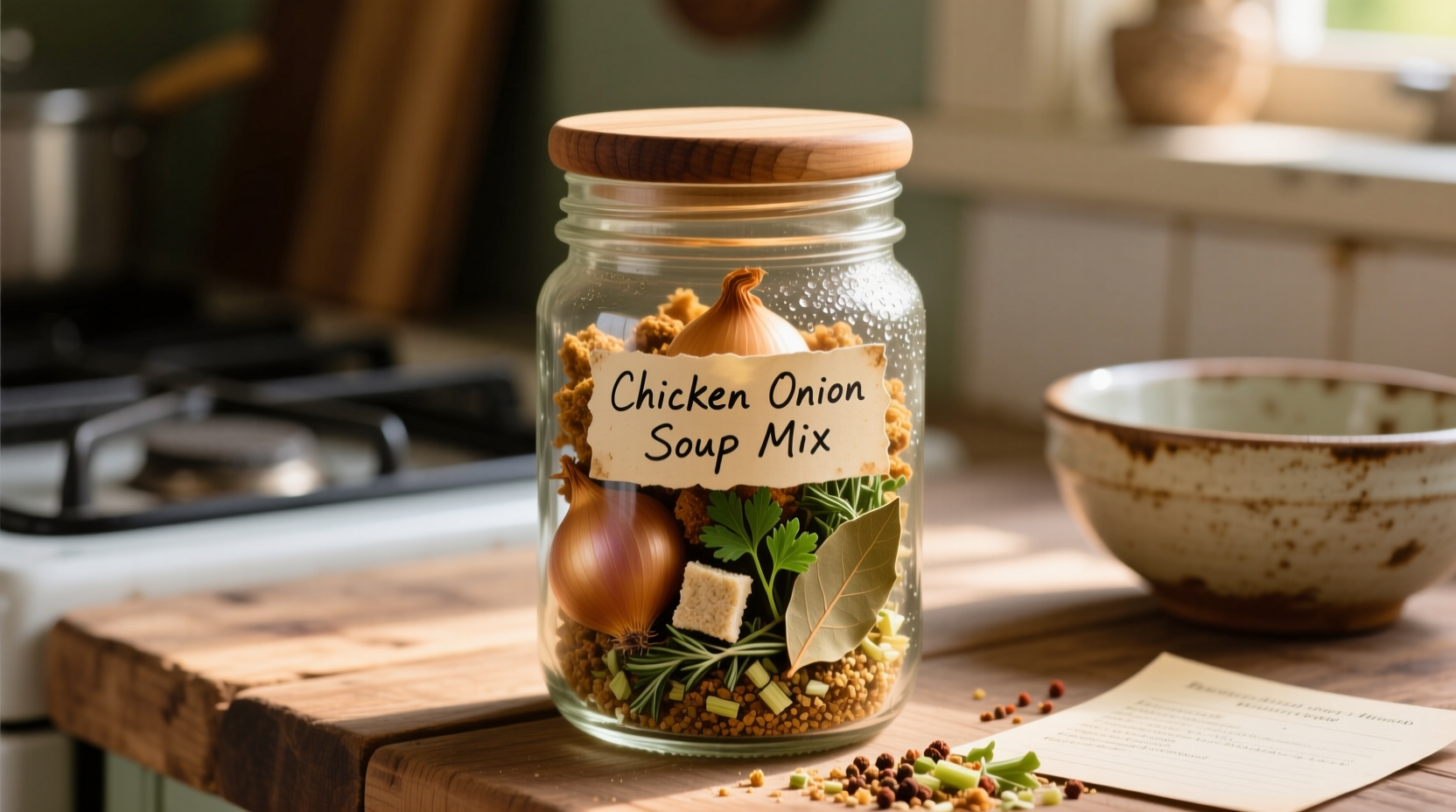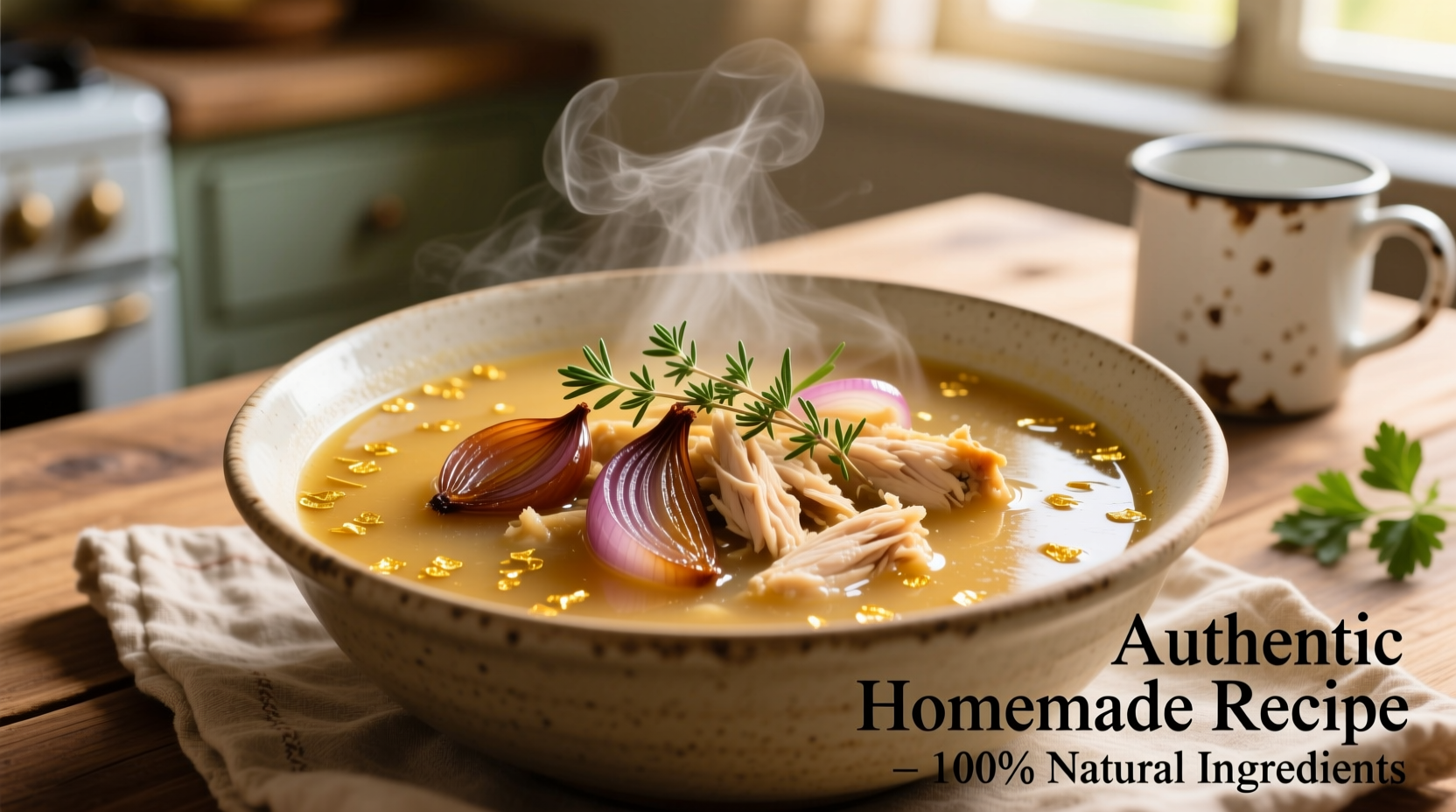Ever wondered how to maximize that box of chicken and onion soup mix sitting in your pantry? This humble ingredient transforms ordinary meals into restaurant-quality dishes with just a spoonful. Whether you're reviving leftovers or creating something new, understanding its potential unlocks endless culinary possibilities.
What Exactly Is Chicken and Onion Soup Mix?
Commercial chicken and onion soup mix typically contains dehydrated chicken broth, onion powder, cornstarch, salt, sugar, and various seasonings. Unlike complete soup products, these mixes serve primarily as flavor enhancers rather than standalone soups. The cornstarch content makes them particularly valuable for thickening sauces and gravies while adding complex savory notes.
| Ingredient | Typical Percentage | Function |
|---|---|---|
| Dehydrated chicken broth | 40-50% | Provides savory umami base |
| Onion powder | 25-30% | Creates aromatic foundation |
| Cornstarch | 15-20% | Thickening agent |
| Salt/sugar/spices | 5-10% | Flavor enhancement |
This composition analysis comes from USDA FoodData Central database entries for standard commercial soup mixes. The precise ratios vary between brands, affecting both flavor intensity and thickening capability.
Practical Applications Beyond the Packet
While many follow the package directions to make soup, professional chefs consistently leverage this mix for more creative applications. The cornstarch content makes it particularly valuable for thickening sauces without altering flavor profiles significantly.
Mastering Sauce and Gravy Enhancement
For every cup of liquid in your sauce or gravy, whisk in 1-2 tablespoons of dry soup mix. This technique provides three benefits simultaneously: flavor depth from the dehydrated broth, aromatic complexity from the onion powder, and perfect viscosity from the cornstarch. Unlike flour-based thickeners, this method won't create lumps and requires no additional fat.
Casserole Secret Weapon
Add one packet to your next casserole recipe in place of salt and additional seasonings. The mix binds ingredients while creating a flavorful sauce as it bakes. For chicken casseroles specifically, reduce added salt by 25% since the mix already contains sodium.

Create Your Own Superior Version
Commercial mixes often contain preservatives and excessive sodium. Creating your own version gives you control over ingredients while costing less per serving. This basic recipe yields the equivalent of one standard packet:
Homemade Chicken and Onion Soup Mix Recipe
- ¼ cup powdered chicken broth (dehydrated)
- 2 tablespoons onion powder
- 2 tablespoons cornstarch
- 1 teaspoon garlic powder
- ½ teaspoon dried thyme
- ¼ teaspoon black pepper
- ¼ teaspoon celery seed (optional)
Mix thoroughly in a bowl, then store in an airtight container. This blend keeps for 6 months at room temperature according to FDA dry ingredient storage guidelines. For richer flavor, toast the onion powder in a dry skillet for 2 minutes before mixing.
Optimal Usage Guidelines
Understanding proper ratios prevents overpowering your dishes. These professional chef-recommended measurements ensure balanced results:
- Soups and stews: 1 packet per 4 cups liquid
- Gravies and sauces: 1-2 tablespoons per cup of liquid
- Casseroles: 1 packet per 6 cups total ingredients
- Meatloaf and burgers: 1 packet per pound of ground meat
When using in creamy sauces, add the dry mix directly to cold liquid before heating to prevent clumping. For acidic dishes like tomato-based recipes, add the mix near the end of cooking to preserve flavor integrity.
Storage and Shelf Life Considerations
Commercial soup mixes maintain quality for 18-24 months when stored properly in cool, dry conditions. The USDA recommends checking for these signs of degradation:
- Clumping or hardening of powder
- Musty or stale odor
- Visible moisture or discoloration
Homemade versions have a shorter shelf life of 3-6 months due to the absence of preservatives. Store both types away from heat sources and direct sunlight to preserve flavor compounds. The National Center for Home Food Preservation notes that exposure to temperatures above 75°F (24°C) significantly accelerates flavor degradation in dried seasonings.
Three Professional-Tested Recipe Applications
Restaurant-Style Pan Gravy
After roasting meat, deglaze the pan with 1 cup broth or water. Whisk in 2 tablespoons chicken and onion soup mix and simmer until thickened. This method creates a rich, complex gravy in under 5 minutes without flour or additional fat.
Flavor-Boosted Meatloaf
Mix one packet of soup mix with your standard meatloaf ingredients before baking. The dehydrated broth penetrates the meat fibers during cooking, resulting in exceptional juiciness. Reduce added salt by ¼ teaspoon to account for the mix's sodium content.
Creamy Herb Chicken Skillet
Sear chicken thighs, then remove from pan. Add 1 cup chicken broth and 3 tablespoons soup mix, whisking until smooth. Return chicken to pan, cover, and simmer until cooked through. The sauce develops restaurant-quality depth with minimal effort.
Common Mistakes to Avoid
Even experienced cooks make these errors when using soup mixes:
- Adding directly to hot liquid: Always mix with cold liquid first to prevent clumping
- Over-salting: Most mixes contain 400-600mg sodium per serving - adjust added salt accordingly
- Using expired product: Flavor compounds degrade over time, resulting in flat-tasting dishes
- Ignoring thickening power: Remember the cornstarch content affects final sauce consistency
According to culinary research from the Culinary Institute of America, properly used soup mixes can reduce recipe development time by 30% while maintaining professional flavor standards. The key is understanding their composition and applying them strategically rather than following package directions exclusively.
When Homemade Beats Commercial
Create custom variations for specific dietary needs:
- Low-sodium version: Replace salt with additional herbs
- Gluten-free option: Use arrowroot instead of cornstarch
- Enhanced umami blend: Add 1 teaspoon mushroom powder
- Smoky variation: Incorporate ½ teaspoon chipotle powder
These adaptations demonstrate why understanding the components of chicken and onion soup mix empowers you to create dishes tailored to your specific preferences and dietary requirements.











 浙公网安备
33010002000092号
浙公网安备
33010002000092号 浙B2-20120091-4
浙B2-20120091-4